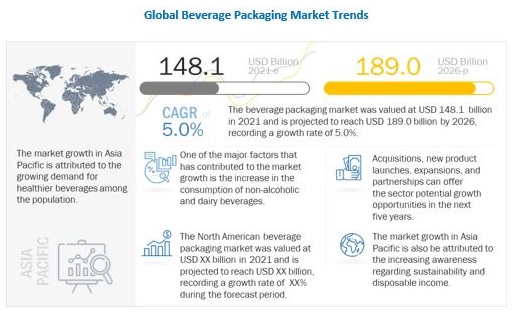
The beverage packaging market was valued at USD 148.1 billion in 2021 and is projected to reach USD 189.0 billion by 2026, expanding at a growth rate of 5.0% during the forecast period. The market is segmented into packaging type, material type, and product type. By packaging type, the market has been segmented into bottle, can, carton, pouch, and other packaging types. The bottle segment is projected to dominate the type segment due to convenience offered in carrying and storing of the formats for beverages. The carton segment is projected to grow at the highest CAGR due to the increase in demand for sustainable and eco-friendly packaging.
The key players making packaging formats for the beverage industry include Amcor Group GmbH (Switzerland), O-I Glass, Inc. (US), Crown Holdings, Inc. (US), Ardagh Group S.A. (Ireland), Verallia SA (France), Tetra Pak Group (Switzerland), Ball Corporation (US), Vidrala S.A. (Spain), Toyo Seikan Group Holdings, Ltd. (Japan), and CPMC Holdings Limited (China) among others.
Download PDF brochure: https://www.marketsandmarkets.com/pdfdownloadNew.asp?id=1222
The increase in the consumption of non-alcoholic and dairy beverages is projected to be some of the major drivers for the growth of the global beverage packaging market. There has been several innovations and development in the packaging designs and packaging technology over the last five years in the global beverage packaging market. The increase in demand for products made from biodegradable and renewable raw material presents lucrative opportunities for the players in the market. The rise in consumption in emerging economies is encouraging the growth of the market
On the basis of material type, the market is classified into metal, plastic, glass, paper & paperboard, and others. Beverage containers can be rigid or flexible. Rigid containers include glass and plastic bottles, metal cans, wood boxes, and drums. They give physical protection to the product inside it. Flexible packaging includes a major group of material types, such as plastic films and papers. Beverage packaging manufacturers combine two or more packaging material types of different characteristics to develop a multi-featured packaging solution that is convenient, safe, cost-effective, and recyclable. Metal segment dominated the market with largest share. The resilience and recyclability offered by metals are the two major factors driving the growth of the market.
Based on product type, the market is categorized as a non-alcoholic beverage, alcoholic beverage, and dairy beverage. The non-alcoholic beverage segment is dominated in the market. A non-alcoholic beverage usually acts as refreshment drinks for the majority of the population. Hence it captures a major market share in the overall beverage market. The non-alcoholic beverage market is flooded with a large number of strong brands of all product categories that make the market highly competitive. Therefore, in order to retain its customers and gain new customers, the players are coming up with a diversified range of products in beverages. The dairy beverage segment is projected to grow at the highest CAGR of during the review period.
Request Sample Pages: https://www.marketsandmarkets.com/requestsampleNew.asp?id=1222
On the basis of the regional area, the market is segmented into North America, Europe, Asia Pacific, South America, and Rest of World (RoW). Due to the increase in population and rise in disposable income, Asia Pacific is projected to account for the largest share during the review period. Global players such as Ball Corporation (US) and Crown Holdings Inc (US) are entering the Asia Pacific market by developing new manufacturing plants in the region. Rapid industrialization and urbanization, increase in environmental concerns, rise in disposable income of growing middle class, and lower production of fresh food & beverage products are factors propelling the usage of processed food & beverage products, consequently fueling the demand for beverage packaging market in this sector.